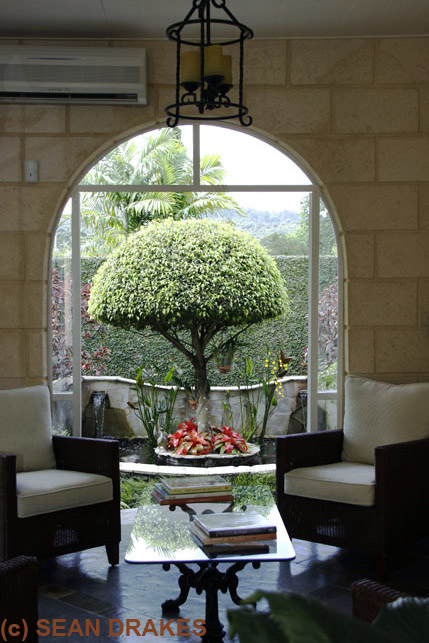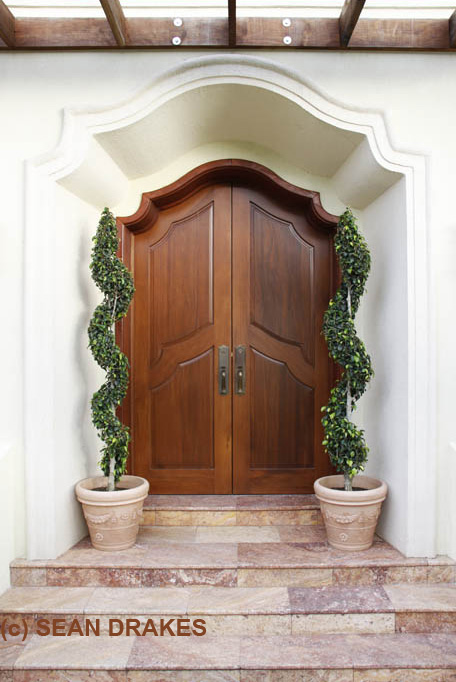Sculptured plants are demanding, distinctive and a growing trend in tropical gardens, here’s a useful topiary tipsheet
Landscaping that includes manicured topiary often evokes visions of palatial European gardens, stately homes, pomp and affluence. Topiary is a living sculpture, an art form and a design medium that supports a global indust ry. In the Caribbean, topiary is patiently growing a loyal following. Gardening enthusiasts in Trinidad credit one passionate landscape architect with introducing topiary to luxury communities across the island, and they fondly call her the ‘topiary queen’.
ry. In the Caribbean, topiary is patiently growing a loyal following. Gardening enthusiasts in Trinidad credit one passionate landscape architect with introducing topiary to luxury communities across the island, and they fondly call her the ‘topiary queen’.
The art of training plants into prescribed shapes, “dates to the first century AD when wealthy Romans would have their initials shaped out of box hedges,” according to landscape architect Natalie Gabriel. “Chinese and Japanese civilizations practiced the art with great vigor with the ingenious stunting of trees (Bonsai) [and] elaborate shaping of plants and shrubs in the gardens. The golden age for topiary was in the gardens of European elite in the 16th and 17th centuries. The most elaborate geometric topiary hedge mazes were constructed in French, British, Dutch and Italian gardens.”
“I [was studying] jewelry design in Florence for two years,” recalls Gabriel, 38, CEO of Trinidad & Tobago Landscaping Co., “and visited many stunning gardens there. I remember being intrigued by topiary and often found myself peering into topiary to examine their trunk structure.” When she returned home Gabriel bought a variety of Ficus plants from farms across Trinidad to experiment with and test various grooming styles, they all ended up in her garden. “They were a hit with my family and friends.” Soon she had a queue of orders for her elegant plant sculptures. In that narrow lull between the dry and rainy seasons, when the skies over Trinidad and Tobago are consistently moderate, Gabriel gave me a tour of her projects in Port of Spain. Then she and her project manager, Lester Charles, tapped their experience to offer this tip sheet on cultivating topiary in the tropics:

What species of plant/tree are best and typically used for topiary?
“Ficus is the plant of choice for topiary locally because they respond well to grooming, bending, twisting, even braiding,” attests Lester Charles. “They are hardy and pest resistant. The choices in plants are endless: roses, citrus, ixoras, eugenia, are a few plants that make great topiary.”
What considerations do you review when you approach creating a topiary?
“First step in creating a topiary is [to] look at what you have to work with, the key [is to highlight] the strong points of the plant trunk structure, branch layering, surface roots structure, leaf size, size of pot (if potted),” explains Charles. “One must consider target size of the finished topiary is kept in botanical and visual scale with the pot. A great part of this art is dependent on imagination, individual skill, dedication, [and] copious amounts of patience and creativity.”
 When a topiary design falls short of the perfection envisioned what are the options?
When a topiary design falls short of the perfection envisioned what are the options?
“If a topiary falls short of the desired design this is where creativity comes in,” asserts Charles. “If the flaw happens in the pruning or grooming process or there is breakage due to the pot falling, you move on to option two or three: the design. This is up to one’s creativity, errors [can] extend the investment in time on the plant exponentially because in order to support proportional shape you have to trim back sections of the plant until the mistake has grown or filled-out [then] resume shaping it.”
The process of sculpting topiary can consume how much time?
“Sculpting time can range from 15-minutes to an hour, to three years, but I would also say the sculpting process with topiary is never truly finished and could really last for as long as you or the plant is alive.”
 Is there a style rule that dictates that topiary should be installed in pairs?
Is there a style rule that dictates that topiary should be installed in pairs?
“There is no style rule that dictates topiary should be in pairs, groups or rows. There is an almost addictive tendency to collect topiary, one never seems to be enough,” offers Gabriel. “In landscape design it’s about harmonious balance between various items in a space. People [often] use pairs of potted topiary to frame the entrance to their home, this is where the ‘topiary in pairs’ belief may have sprung from, topiary at the entrance to a home creates drama.”
What are some of the don’ts when it comes to employing topiary in a garden?
“Some precautions that one should adhere to when employing topiary in a garden,” suggests Charles, “consider maintenance, quality of grooming services available, choice of plant type and its suitability to location or soil type, style of garden, its placement in garden and consider if it will disrupt the garden’s balance. These are factors to be mindful of when contemplating if topiary [is] suitable for use in [a] garden.”
© SEAN DRAKES
[ 404.654.0859 | SEANDRAKESPHOTO@gmail.com ]














